



Trans-gender theorist Jami Weinstein has compared the flocking behaviour of academics and artists around the concept of The Anthropocene, to the adoption by the Hipster of a given locale or fashion appendage. The creative flock, she suggests, can perform a gentrification of concept through uncritical adoption and ‘hyper-consumption’, just as it does of neighbourhoods or workwear. The Anthropocene is indeed the place to be seen, or the guise in which to dress the body of your work, this season. The term is proposed as a way of describing the explicit ‘age’ in which human kind, post-1945 (although possibly since the Industrial Revolution, or stretching right back to the advent of tool use), has come to define the geophysics of the entire earth.
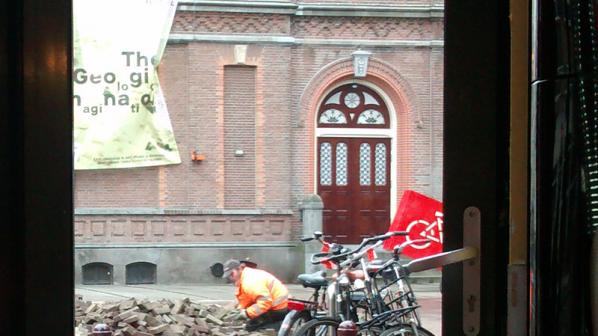
The Anthropocene, combining geology with sociology through a few slights of hand, therefore collapses the distinction of human and nature which is core to basic understandings of our being in the world. If this wasn’t enough, an immanent vote affirming the accuracy of the term The Anthropocene by the scientific community worldwide has also been touted as a gesture which will provide the rhetorical turning point by which the Western powers will acknowledge, and begin reparations for, the ecological sins of the past, potentially saving the human race from mass extinction. Fertile ground then, for readings, interpretations and responses – but as Weinstein suggests, there is a deeply complex responsibility implied when we approach and engage with something as ontologically vulnerable as a concept.
It is this responsibility Sonic Acts assumes when it takes The Anthropocene as its central theme. The four day music festival and conference takes a collection of essays titled The Geologic Imagination as a gathering point for a strong line-up of some of the most influential men working across philosophy, music and the arts today. I attended the first day of the festival, which included a talks and a round-table by Object Oriented Ontologists maverick Graham Harman and his icemanTim Morton, geologist Mark Williams, and art theorist Douglas Kahn, followed by a performance/installation by Florian Hecker featuring work by Reza Negarestani, and a night-time programme of music by M.E.S.H and TCF, Vessel, and finally, as if from outer space, the sole female agent of the programme, Karen Gwyer.
I use the term agent, to distinguish from ‘appearance’ or ‘voice’, because there were several female bodily appearances and women’s voices in evidence onstage during the conference and club. The problem was that they were routinely either denied the right to articulate their own words, for example when The Geologic Imagination editor Mirna Belina was reduced to acting as an interlocutor for Lukas Marxt during a poorly thought out artists presentation section; or worse, used as sound/image material to be cut into, destroyed, and literally degraded for surface affect by male artists. Example of this included the snippet Kurt Hentschläger showed of his work Modell5, during an inexplicable tour of his online portfolio – and the violent envelope-ing of Charlotte Rampling’s vocal performance in Hecker’s audaciously dense new materialist sound opera Script for Machine Synthesis. Certainly none of these phenomena may have stood out as malicious in themselves, but in the context of a festival whose line-up consists of 75 men and only 7 women, and whose female curators are entirely absent from the staged elements of the show, a motif in which women’s bodies and voices are a pretty fabric to be torn and disabused begins to gain the qualities of something else entirely. The ‘glitch’ too must take into account its gender dimension.
This unfortunate gender play reached its misogynistic anticlimax during the closing stages of the club event as the trashy, industrial techno of Vessel was backed by a huge split-screen visual (film created by Pedro Maia) of a woman crying in a bathroom, lying in a corridor naked, kissing another woman in a body bag, and finally being pulled limb from limb in an ambiguous mix of sex-scene and analogue-digital disintegration. What does the complicity and collectivism of a rave space do with images/sound combinations like this when they are conducted by men?
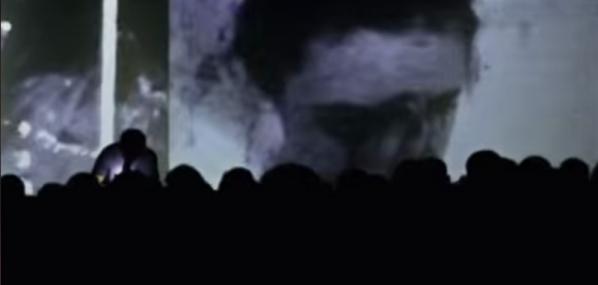
Early in his presentation, delivered with Tedtalk panache, Tim Morton used the fact that literary theory reads gender into texts even when they do not ostensibly mention gender, as an analogy for the way OOO recognizes that objects often ‘withdraw’ from us some core aspect of their being. As Morton affirmed, the Anthropocene is itself a “subcendent” object, being ‘much less than the sum of its parts’ – its parts being of a scale and complexity which must necessarily withdraw from us in order that the concept-as-object here can be revealed. This is explicitly not to infer that the concept-as-object can be emptied of its cultural and social identity and worn with Nikes like a naval overcoat, but rather that it requires a subtle and supple mode of thinking which is capable of excavating ‘that which withdraws’. The gender comment then, was prescient – directly illustrating that the curators, Lucas van der Velden and Annette Wolfsberger undermine the moral agenda of their project by failing to consider, or dismissing, the gender dimension. It might have been a calculated risk, that by not paying attention to gender during their deliberations they might elide that concept altogether from the consideration of the festival, but I think that when a risk backfires like this, the result should be called out for what it is – misguided and arrogant. At times, it felt like rather than proposing ways in which we might retreat from rampant, destructive territorialisation of the Earth, the festival projected a future in which the masculine regime of ownership and domination as ruinous could be helpfully extended and repeated onto womanhood as well – with all the faulty binarism and barbarism that implies.
The one audience question of the day, delivered from under a spotlight and with the barely subdued fury which gave him the air of Rasputin. His question, directed at Harman and Morton, I think picked up on some of the air of hypocracy of the event, but concerned the application of OOO specifically, and its relationship to Accelerationism. As my friend put it, “OOO qua Accelerationist gateway drug”. Needless to say, the question was expertly fielded and evaporated almost without trace.
Despite the regularly fascinating philosophical and cross-disciplinary gestures being made across the discourse/music strands, then, Sonic Acts was articulate through the voices it chose to exclude.
Not that the work itself, or the conversations happening across the theoretical and art strands was insubstantial. For example the way in which electronic artist TCF’s sound work performed the ontological flattening of objects as diverse as a helicopter, a computer circuit, and a Euro-house drop reflected brilliantly on the ideas proposed by Harman, Kahn and Morton, and gave a very tangible way of understanding the new materialist connotations of all. Another highlight included the Reza Negarestani double-bill, in which his notion of the incompatibility of given systems and the resulting philosophical imperative for ‘mixed-level reconfiguration’ through analyzing as both ‘that we can perceive’, and ‘that which we know’, for example, was first purposed as philosophical libereto, and then delivered as an almost equally dizzying Skype lecture.
During the deeply cerebral and attention-demanding ‘Script…’ performance, in which the audience were all seated on the floor, someone tall in mirrored sunglasses did a Jameroqui type dance while people filmed him on their mobile phones.
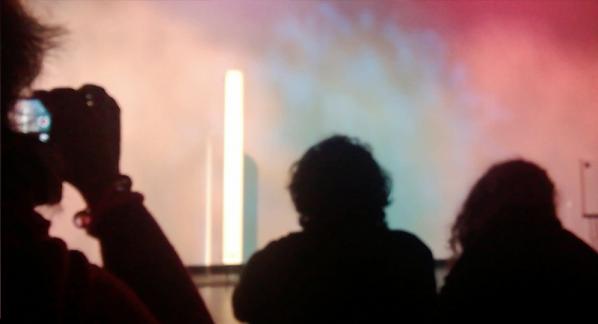
In Script for Machine Synthesis, (and previous works, such as Chimerisation) Florian Hecker has found in Negarestani’s philosophy a fantastic foil for his ‘dramatization of auditory synthesis’. Script used the motif (and the ‘occasion’) of a melting pink ice cube to enact a simultaneous synthesis and dematerialisation, bringing audio and scent (a specially commissioned perfume by Editions De Perfumes ‘materialised into a rubber trophy presented to each audience member in a foil envelope which made me think of space rations) into play as operators in the field of deconstructing the object-as-concept.
As an audience member completely new (but predisposed) to Negarestani’s work, following this hour-long performance with a lecture via Skype in which he laid out a the chiasmic twisting across neurological-phenomenological and mathematical-physical poles of experience and knowledge, led to a dizzying sense of having been teleported and improperly put back together.
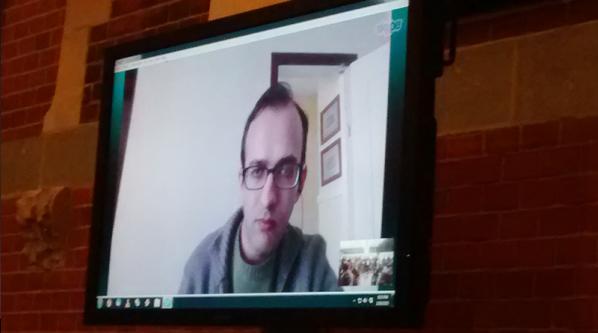
But, despite of these admirable folds in the art/thought continuum, it was impossible to shift the unnerving sense of hypocracy and lack of critical rigour at play in Sonic Acts programming. To return to the central unspoken chimera: The Anthropocene is gendered. In its simple form, it refers to a catastrophic situation resulting from the actions of a patriarchal Western society, and the effects of masculine dominance and aggression on a global scale. This was this subject in withdrawal which dominated my experience – meaning that a curatorial oversight not to include women, presumably in order to include more ‘famous’ names from these male-dominated spheres, was allowed to resonate and mutate into an experience of pervasive, almost hedonistic, misogyny I experienced during the Vessel performance.
The notoriously affluent European festival circuit benefits from a dense network of national and EU funding schemes, coupled with the neoliberal ease of intra-continental transport, cheap flights etc., and leverages this in an arms-race of fees for a mostly-male mostly-white cohort of mostly-electronic music artists. This context, plus that of the ‘lavishly illustrated’ book of essays which sets the scene for this year’s Sonic Acts, and the mode of staging in which the expert-community of the audience was silenced from contributing, in favour of a series of pronouncements from master-rhetoriticians, seems to me in direct opposition to the kind of ‘challenge to the status quo’ and subsquent reversal of the Earth’s fortunes which was frequently advocated for. The blurb for The Geologic Imagination does in retrospect seem to revel in the kind an uncritical adoption of concept Weinstein critiques, making of ecological disaster mere concept for further consumption:
“This new publication by Sonic Acts is inspired by geosciences and zooms in on planet Earth. Fundamental to The Geologic Imagination is the idea that we live in a new geological epoch, the Anthropocene. (!) Human activity has irreversibly changed the composition of the atmosphere, the oceans, and even the Earth’s crust. (!) Humanity has become a geological force. (Huzzah!)” [Exclamations mine.]
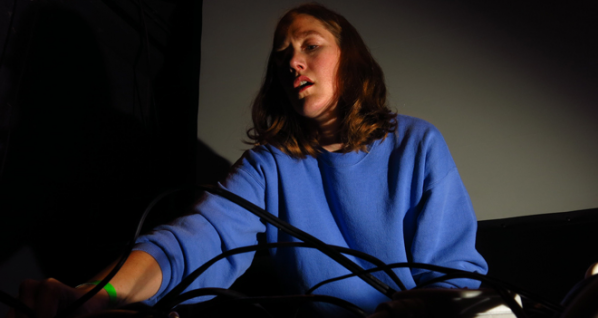
Finally, Karen Gwyer’s techno set – devoid from any descernable link with the festival themes, and so in a way also silenced somehow. But nonetheless, experienced like finally being able to breathe. The bass subdued among a mesh of pulsating synth and crystalline threads. Tim Morton’s frenetic big-box-little-box dance moves notable in the throng, somehow saying something indiscernible but very real, about the opportunities missed by this most-preeminent of European festivals. As Gwyer herself notes, in an interview not at all about the Anthropocene: “those forces have testicles.”
[imgs Jon Davies]
http://fossbox.org.uk/content/sex-and-security
A two-day event by Fossbox in collaboration with Furtherfield and Autonomous Tech Fetish around surveillance, gender and society. The event will consist of a practical privacy workshop followed by a day of discussion, making and performance. Open to everyone, women/LGBTQ especially welcome.
Practical workshop on privacy and security: 7 March, 11am
A focused exploration of the issues around sexuality, gender and surveillance. Visit this Meetup Group to join.
Discussion workshops – sex and surveillance: 22 March, 11am
A workshop using play, performance and discussion to develop a better understanding and a more collectivised civil response around these issues. Visit this Meetup Group to join.
If you’re hazy about how digital mass surveillance works and what you can do, you’ll get most out of it by attending both workshops. If you already know about the tech side, you might want to help out at the practical workshop!
The ‘Internet of Things’ (IoT) is heralded as a quantum leap in economy, society, culture and government — yet most people outside of the tech and creative industries struggle to get their heads around what this really means. A number of recent scandals involving ‘smart’ devices as well as Snowden’s revelations have highlighted the huge and slightly scary security and privacy issues at the heart of our brave, new, cyberworld. ICO and Offcom are acutely aware that this pervasive surveillance is making a mockery of current EU/UK privacy legislation which urgently needs an overhaul. Policy, however, prioritises rapid development of IoT over protecting sensitive data calling for ‘transparency’ rather than restriction of how our data can be collected and used. Meanwhile, the corporate and governmental chorus that law-abiding citizens have nothing to worry about from pervasive surveillance is wearing thinner every day.
As the digital domain begins to bleed into our ordinary, physical surroundings, the government is telling us that we don’t need privacy and even wants to outlaw the secure encryption which can protect our private life from being used for invasive profiling, ending up on public websites and social media, or on sale in the data black market. Cameron has stated that there should be absolutely no communication or data which the government can’t read. Is it really OK for corporations to compile and sell personal profiles so intimate that they know more about us than our loved ones do? Does the government really have a right to gather and keep our every private thought to be used in profiling if we ever do fall foul of the state for whatever reason? There is already a discussion of the ‘militarisation’ of social science and ‘predictive policing‘ – we’ve seen in the past which vulnerable groups are most likely to be targeted for profiling. What about the constant monitoring and manipulation of movement around cities. What if our government takes even more steps to the right whilst conditions get harder for most of the population. What if there were mass protests? What if a future right-wing government outside the EU decided to outlaw LGBTQ? What might these ubiquitous personal dossiers and pervasive control of urban space be used for then? Are we sleepwalking into a society where everyone is always-already a criminal and non-conformity or protest is no longer an option?
These developments are going to affect everyone but there are many issues around online security which will have particular resonances for women and queers and may affect us in very specific ways. There has been a lot of discussion and press about gender-trolling, ‘revenge porn‘, ‘gamergate‘ and Wikipedia, the ‘quantified self‘, FB real-names policy and binary sex dropdown lists in databases — to name but a few. However, there is not very much discussion about how these issues all fit together and what the overall impact of this production of digitised social space, hyper-self-awareness, and networked sexuality might be for women, queers, and marginalised groups. How does corporate and government surveillance and profiling affect our sense of self, our personal and public spaces, and our freedom to speak and organise with other women and queers? Where is the line between design which facilitates us and design which manipulates us?
The issues are hard to wrap your head around and keeping your private life private requires the commitment of a little effort — it can interrupt the manicured flow of our digital ‘user experience’. You might not really want to know what happens after you push the little button that says ‘send’ but staying safe online in 2015 and beyond is going to get a little bit more challenging. Not caring is going to be an increasingly risky option.
Technical solutions are needed, and a small army of ‘infosec’ practitioners, strong encryption, and hardened systems. However, this won’t be enough because USA, UK and EU governments are more concerned with corporate profits and the security of their own power than with the safety and wellbeing of civil society. Alongside our own private actions to secure our own data and the efforts of civil-society-hackers, non-profits and NGOs striving to keep us informed, skilled, and safe, we also need an aware and empowered civil society response. But is ‘smart’ economy an all-round bad idea purely to be defended against or is there the possibility of ‘smart’ technology and smart systems co-designed by and for women themselves and a respectful way to manage ‘big data’?
Opening Event: Seeds Underground Party – Sat 31 August, 2-5pm
Contact: info@furtherfield.org
Visiting Information
ABOUT THE EXHIBITION
ABOUT THE ARTWORKS
ABOUT THE ARTISTS
EVENT: SEEDS UNDERGROUND PARTY
TALK: SHU LEA CHEANG – ART, QUEER TECHNOLOGIES AND SOCIAL INTERFERENCE
LOCATION
SEE IMAGES FROM THE PRIVATE VIEW
WATCH VIDEO OF THE OPENING
This exhibition by Mark Amerika (US) and Shu Lea Cheang (US/FR) at Furtherfield Gallery marks a significant moment for contemporary art. Amerika and Cheang are both ‘net native’ artists. They share many of the obsessions of the growing multitude of artists who have grown up with the net since the early 1990s.
They are also big “names” – internationally established artists who regularly show their work, to critical acclaim, at contemporary art galleries around the world. They have crossed over into the mainstream art world whilst maintaining a critical edge.
Amerika is a media artist, novelist, and theorist of Internet and remix culture, named a “Time Magazine 100 Innovator” in their continuing series of features on the most influential artists, scientists, entertainers and philosophers into the 21st Century.
Cheang is a multimedia artist who works with net-based installation, social interface and film production. She has been a member of the Paper Tiger Television collective since 1981 and BRANDON, a project exploring issues of gender fusion and techno-body, was an early web-based artwork commissioned by the Guggenheim Museum (NY) in 1998.
Both artists continue to shape and be shaped by contemporary networked media art cultures of remix, glitch, social and environmental encounters.
Shu Lea Cheang and Mark Amerika at Furtherfield Gallery provides a physical interface in a local setting in the heart of a North London park to the thriving, international, networked art scene.
The exhibition features Cheang’s UKI viral love installation and Composting the Net. These are shown alongside pieces from The Museum of Glitch Aesthetics (MOGA), Amerika’s latest work in his collaborative series of transmedia narratives.
The exhibition features large stills from two performance installations. UKI viral love is the sequel to Cheang’s acclaimed cyberpunk movie I.K.U. (premiered at Sundance Film Festival, 2000) conceived in two parts – a viral performance and a viral game. The story is about coders dispatched by the Internet porn enterprise, GENOM Corp, to collect human orgasm data for mobile phone plug-ins and consumption. In a post-net crash era they become data deprived and these coders are suddenly dumped into an e-trashscape environment where coders, twitters, networkers are forced to scavenge from techno-waste.
![UKI – Trash Mistress [Radíe Manssour] (2009) by Shu Lea Cheang – Photo by Rocio Campana](http://www.furtherfield.org/wp-content/uploads/2013/05/radie.jpg)
In 2009, Cheang moved into the art studio at Barcelona’s Hangar medialab with 4 tons of E-trash, collected in Barcelona’s city recycling plant in one day. Amidst the rubble of wires, cables, boards, keyboards and computers, along with the coders and the hackers, UKI the defunct replicants are part of the e-trashscape seeking parts and codes to resurrect themselves.
UKI viral love is developed with collaborations and residencies at HangarBCN [artistas residentes] (Barcelona, Spain), Medialab Prado [Playlab] & [Desvisulizar] (Madrid, Spain) and, LABoral Centro de Arte y Creación Industrial [Plataforma Cero] (Gijón, Spain). The work presented at Furtherfield Gallery is the first physical installation of UKI in a gallery setting.
Composting the Net sources Internet net cultures’ accumulated data. It appropriates open (un)moderated mailing list communities, used for collaboration, sharing information and dialogue, and reprocesses the information into a virtual compost. For this exhibition Cheang composts the Spectre mailing list, a channel for practical information and exchange for media art and culture in “Deep Europe”, initiated in August 2001. The abundant info-data is reused and given extra life – an artistic legacy beyond its original purpose. It is also a celebration of the independent spirit of net culture that exists outside of corporate dominated Web 2.0 platforms such as Facebook.
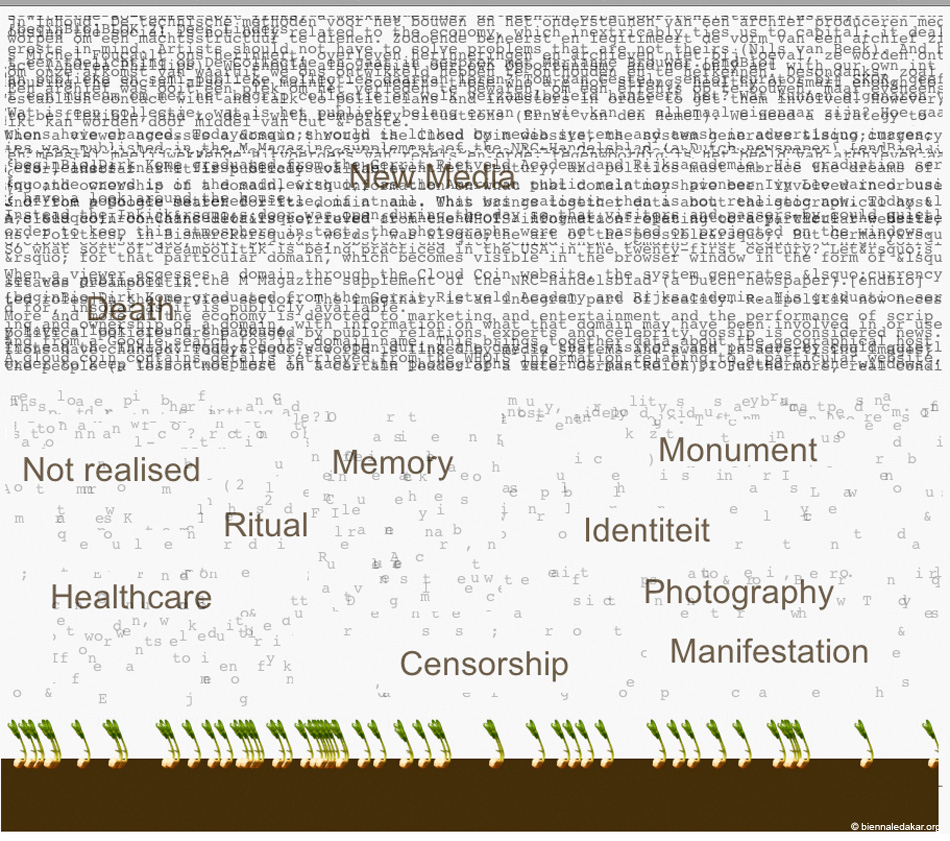
Amerika’s The Museum of Glitch Aesthetics (MOGA) features the work of The Artist 2.0, an online persona whose personal mythology and body of digital artworks are rapidly being canonized into the annals of art history. The narrative traces the life of the artist and his ongoing commitment to a practice of ‘glitch aesthetics’. MOGA features a wide array of artworks intentionally corrupted by technological processes, including net art, digital video art, digitally manipulated still images, game design, stand-up comedy, sound art, and electronic literature.
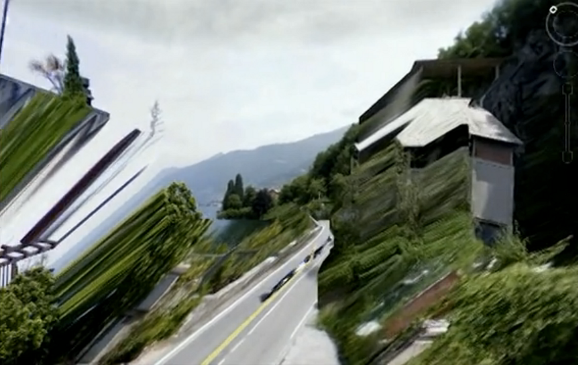
Featured in the Furtherfield Gallery exhibition are three works from the MOGA series: Lake Como Remix, The Comedy of Errors and 8-Bit Heaven.
Museum of Glitch Aesthetics was commissioned by Abandon Normal Devices for the 2012 AND Festival.

In conjunction with Shu Lea Cheang and Mark Amerika exhibition opening, Furtherfield is pleased to host Shu Lea Cheang’s Seeds Underground Party on Saturday 31 August, 2-5pm. Join us for a seed exchange party where packets of seeds change hands and go underground in the fields around Finsbury Park.
+ More information about the Seeds Underground Party.
To coincide with the exhibition, on Monday 02 September The White Building hosts a special talk by Shu Lea Cheang who will be in conversation with curator and writer Omar Kholeif.
+ More information about the Event.
Mark Amerika
Mark Amerika’s work has been exhibited internationally at venues such as the Whitney Biennial of American Art, the Denver Art Museum, the Institute of Contemporary Arts in London, and the Walker Art Center. In 2009-2010, The National Museum of Contemporary Art in Athens, Greece, hosted Amerika’s comprehensive retrospective exhibition entitled UNREALTIME. He is the author of many books including remixthebook (University of Minnesota Press, 2011) and his collection of artist writings entitled META/DATA: A Digital Poetics (The MIT Press, 2007). Amerika is a Professor of Art and Art History at the University of Colorado at Boulder and Principal Research Fellow in the Faculty of Humanities and Social Science at La Trobe University.
Shu Lea Cheang
As an artist, conceptualist, filmmaker, networker, Shu Lea Cheang (USA/France) constructs networked installation and multi-player performance in participatory impromptu mode. She drafts sci-fi narratives in her film scenario and artwork imagination. She builds social interface and open network that permits public participation. Engaged in media activism with transgressive plots for two decades (the 80s and 90s) in New York City, Cheang concluded her NYC period with the first Guggenheim Museum web art commission/collection BRANDON (1998-1999). Cheang has expanded her cross-genre-gender borderhack performative works since relocating in Eurozone in 2000. Currently situated in post-net BioNet zone, Cheang is composting the city, the net while mutating virus and hosting seeds underground parties.
Furtherfield Gallery
McKenzie Pavilion, Finsbury Park
London N4 2NQ
T: +44 (0)20 8802 2827
E: info@furtherfield.org
Furtherfield Gallery is supported by Haringey Council and Arts Council England.
This exhibition is sponsored by Rowans Tenpin Bowl, Carroll/Fletcher and Arts Catalyst.
Featured image: Lynn Hershman Leeson Portrait (Photo Credit: Ethan Kaplan)
Woman, Art & Technology is a new series of interviews on Furtherfield. Over the next year Rachel Beth Egenhoefer will interview artists, designers, theorists, curators, and others; to explore different perspectives on the current voice of woman working in art and technology. I am honored to begin this series with an interview with Lynn Hershman Leeson, a true pioneer in the field who has recently produced !Women Art Revolution- A Secret History.
Over the last three decades, artist and filmmaker Lynn Hershman Leeson has been internationally acclaimed for her pioneering use of new technologies and her investigations of issues that are now recognized as key to the working of our society: identity in a time of consumerism, privacy in a era of surveillance, interfacing of humans and machines, and the relationship between real and virtual worlds. She has been honored by numerous prestigious awards including the 2010-2011 d.velop digital art and 2009 SIGGRAPH Lifetime Achievement Awards. Hershman also recently received the 2009 John Simon Guggenheim Memorial Foundation Fellowship, an award which supported her latest documentary film !Women Art Revolution – A Secret History.
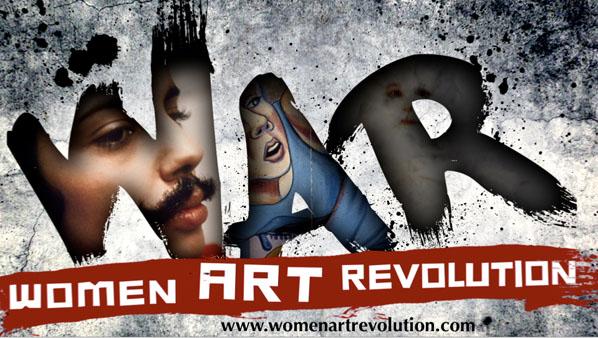
Rachel Beth Egenhoefer: Your most recent project is the film “!Women Art Revolution” which you have been collecting materials for and working on for the past forty years. Why is now the time to present it as a finished work?
Lynn Hershman Leeson: TECHNOLOGY! The film is one narrative, but I’ve put the entire 12,428 minutes online through Stanford University Library, making all the narratives and aterials accessible, so in effect there are no out takes. Also the RAWWAR org archive/website allows people to continue the story online. So the story continues to grow beyond the single narrative, which technology allows us to do now.
Additionally, I wanted to push out into public view the graphic novel, curriculum guide, and the story to affect the legacy while women who created the movement could be appreciated.
RBE: Can you expand on how you see the RAWWAR story continuing online? Or maybe what is the goal of the archive/website? Do you envision people adding to it?
LHL: Yes, it was made specifically so that people, especially younger generations will be able to add information. At the Walker Art Center, they have scanning stations and are training people how to upload work onto the site. My hope is that people from around the world will add materials and it will be a living repository of this type of growing and accessible information.
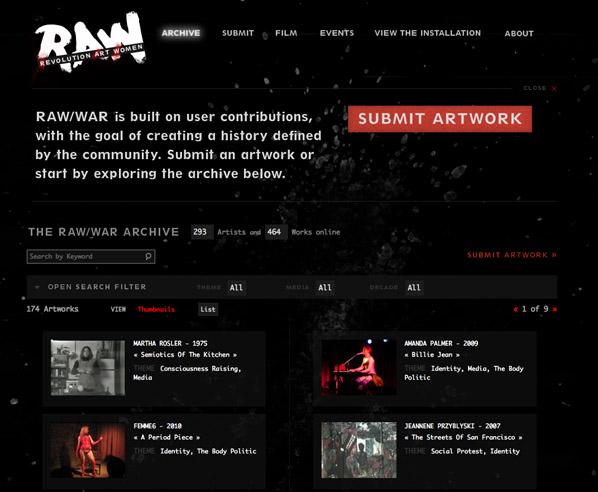
RBE: The film has been touring in the U.S., what has the response been?
LHL: Incredible. It has been in over 60 cities, and standing ovations in San Francisco, Houston, Toronto, Sundance, Berlin and Mexico City. People seem deeply affected by this secret history and seem to appreciate knowing about it.
RBE: Has the response varied either with geography or current events?
LHL: Not really, it seems vibrantly appreciated worldwide despite it being about women in America.
RBE: Can you explain the grammar behind the title “!Women Art Revolution”?
LHL: If you mean why the ! first, it was so we would be listed first, rather than under W. It didn’t work, but that was why we did it originally. It also is a wild exclamation at the start, which is what the movement was.
RBE: The film is described as presenting the relationships between the Feminist Art Movement and the anti-war and civil rights movements, showing how historical events sparked feminist actions. Do you see any connections to be made with the current Occupy Movements?
LHL: Yes, absolutely. In some ways because it is about how the disempowered and invisible people were able to gain their place in culture; how people who had their voices silenced were able to amplify their message and subverted social systems, with work that expressed censorship, freedom of expression, social justice and civil rights and directly made political change. It is an inspiring story of reinvention.
The goals were clearer than with Occupy. But the disenfranchised edges of culture is similar.
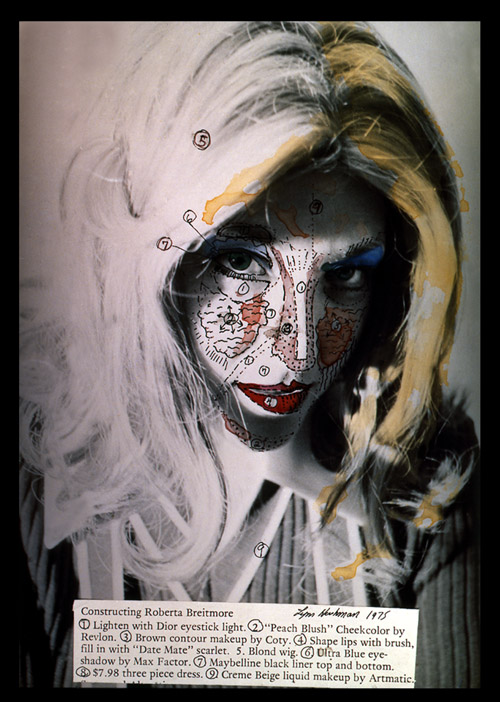
RBE: A lot of your early works dealt with issues of identity. How do you think the notion of identity has changed over the years?
LHL: It has become more technological, more global, more cyborgian. We now, because of the internet are linked globally and that has resulted in a “hive mind” and in turn, that seems to be a cohesion and holding together the individual fracturing that had occurred over the last two decades
RBE: Can you expand on the idea of the “hive mind that seems to be holding together the individual fracturing”? What makes up the hive, what is fracturing us? Is this good or bad or neither?
LHL: The hive is social media and people who participate in the Internet grammar. There is a congealing through access to information. As individuals, I think we have been fracturing, rupturing, split for decades and have become multi faceted and multi taskers. But there’s a price in the lack of personal cohesion that results. I think that having a common reference or ‘hive’ is a very good thing, as it tests our idea of ‘reality’, and serves as a hub of communication.
RBE: Do we make our own hives? Or are those defined for us (either by others/ FaceBook/surveillance/ etc)?
LHL: We are all part of global re-patterning that is happening live on a global scale and it is naive to assume we can act independently or not be connected or affected. We are constantly challenged, influenced by peripheral and pervasive information and in turn we have become fodder for surveillance and digital integration.
RBE: Some contemporary artists and thinkers have been critical of our online selves and physical selves. Sherry Turkel for instance has described people as “performing themselves” online by constantly updating Facebook profiles, tweets, etc to show an ideal version of ourselves. Can you draw any distinctions between virtual, physical, and performative selves?
LHL: I think we perform ourselves every day, not only on social media, but in all interactions. I do not think all images or versions of ourselves are ideal. There is absolutely a difference between real/physical and virtual selves. They each have a context, reference and function. As far as being performative, that depends upon the distinction used for how it is used. One can, in fact, consider life itself and everything one does as performance.
RBE: This interview is going to be part of a series of interviews with women working in Art & Technology. What do you consider to be important today about being a woman working in art & technology?
LHL: Ada Lovelace wrote the first computer language, Mary Shelley envisioned artificial intelligence, Hedy Lamar invented spread spectrum technology, which led to cell phones. Women have been enormously prescient in visioning and affecting the future of the world through technological linkage systems.
RBE: Do you think it is still useful to discuss the female voice as a separate voice in the field?
LHL: I think the female voice is critical in all aspects of the future and should not be limited to a category.

RBE: One of your earlier works, LORNA, depicts a woman who never leaves her apartment and becomes more and more fearful as she watches ads and news on the TV. Some might say television media has gotten far worse since the 80s in both fear mongering and controlling conversations. What do you think about the current state of the media?
LHL: Right, the idea of media as totally affecting our outlook has shifted. Media is no longer omniscient! The 99% are activating their voices and warbling into existence. There are other problems with social media… deeper ones that splay into the cracks of fractured identities and insist on more disruption and lack of focus. But perhaps that is what is affecting our constantly changing evolution.
RBE: If LORNA were around today what would she be thinking or doing in her little 1 room apartment?
LHL: Blogging and all forms of social media including excessive and obsessive shopping, no doubt. She would probably not really be agorophobic either. She would, however, probably be paranoid. She would use a webcam and notice all the ones surrounding her no matter where she moved.
RBE: Do you have hope for change in the future?
LHL: Hope? It is inevitable. I believe in the next generation! They always, in their amnesiac optimism re invent the future in ways that can’t be predicted.
RBE: You have been involved in academia for some time, what do you think is important to be teaching in the Universities right now?
LHL: Independent thinking and creativity, the maintenance of ethics and a profound sense of humor!
RBE: Do you have any new projects you are working on?
LHL: Yes, at least 3 .A new film which is part 3 of my trilogy about the evolution of the human specis, a new installation that uses scanned beating heart cells, and a long term project about Tina Modotti.
Find our more on Lynn Hershman Leeson and Woman Art Revolution here: http://www.lynnhershman.com/http://womenartrevolution.com/
Featured image: Screenshot from an online magazine that advertises sex with others
Ivan Pope’s latest work and project ‘Couples’ crawls into one’s psyche as he manages to unearth a seemingly timeless activity that, in the contemporary world, functions as a networking activity between millions of people worldwide. We are all now probably accustomed to the idea that it occurs on the Internet and that there are swingers regularly contacting each other and arranging liaisons through it. Instead of concentrating on such subterranean mutuality and its pursuits on a digital medium like the Internet, Ivan has collected his information from a magazine such as ‘Matchmaker’.
Yet this is not the only magazine out there being rabidly collected by these flesh swappers (may be you are interested). Many of them possess curious titles such as ‘Women in Jail’, ‘Adult Fun Times’, Liberated Women’, ‘Fads and Fantasies’, ‘Subs and Doms’ and of course ‘Couples’. They are usually bi-monthly issues containing contact catalogues showing explicit photographs of people exhibiting themselves.
The works that you see here are a small selection of a much larger growing collection. In actuality they are presented in the form of larger Inkjet prints, measuring up to two meters high. Thus reflecting upon our selves the viewer when observed (in the flesh) a human scale experience. This consciously aware figurative art declares a social context showing text with the images of people’s measurements, eyes and hair colours, height, false and alias names, desired requirements and contact details.
James Hillman the Archetypal psychologist said that ‘The sexual fascination is the soul trying to get out and get into something other than itself’. Which kind of explains not just the functionally of this habitual occurrence to a small degree but it also casts light upon the emotional side of it and why there are so many people out there in the world trying to meet each other this way, even when it seems that they are content with being with another singular loving entity. A subculture that swaps flesh not only goes through the process of swapping their physical selves, their bodies but also they share consciousnesses. There is a sense that many people feel an intense urgency to fulfill their desires (not need) by immersing their physical frames with others. Exploring their anonymity, letting go of the everyday nonsense that we all have to deal with, such as politics, paying bills, family struggles, wars and even love.
‘I was carried by the conviction that I rejoiced in extraordinary freedom. To fuck above and beyond any sense of disgust was not just a way of lowering oneself, it was to raise your self above all prejudice. There are those who break taboos as powerful as incest. I settled for not having to choose my partners.’ Catherine Millet. The Observer, Sunday May 19, 2002.
As I look at ‘Couples’ I am subjected to the unnerving realization that what I am seeing is also a kind of cattle market, flesh being sold on to those who long to possess them. They are also actually photographic images of real people rather than illustrations, cartoons, paintings; adding weight to the pieces with an undeniable raw intensity. Yes, it is dark. Yet it is also a barometer, a brutal signifier carrying with it an honest realism that we are more complicated, more connected to our visceral and feral identities than supposed civilized society acknowledges and lets on and informs us all to be.